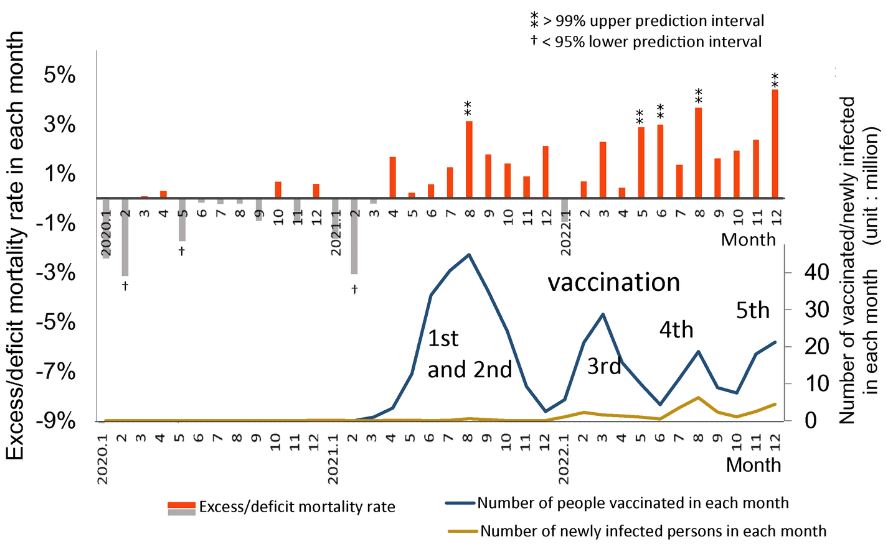"Abstract: ... [T]his study aimed to evaluate how age-adjusted mortality rates (AMRs) for different types of cancer in Japan changed during the COVID-19 pandemic (2020-2022). Official statistics from Japan were used to compare observed annual and monthly AMRs with predicted rates based on pre-pandemic (2010-2019) figures using logistic regression analysis. No significant excess mortality was observed during the first year of the pandemic (2020). However, some excess cancer mortalities were observed in 2021 after mass vaccination with the first and second vaccine doses, and significant excess mortalities were observed for all cancers and some specific types of cancer (including ovarian cancer, leukemia, prostate cancer, lip/oral/pharyngeal cancer, pancreatic cancer, and breast cancer) after mass vaccination with the third dose in 2022...

Discussion
... For all cancers, we estimated the excess mortalities to be -0.4% (-0.9, 0.1), 1.1% (0.5, 1.8), and 2.1% (1.4, 2.8), respectively, indicating no excess in 2020 and statistically significant increases in 2021 and especially in 2022...
Influence of multiple mRNA-LNP vaccine doses
... Researchers have reported that the SARS-CoV-2 mRNA-LNP vaccine may pose the risk of development and progression of cancer. In addition, several case reports have described cancer developing or worsening after vaccination and discussed possible causal links between cancer and mRNA-LNP vaccination...
Thrombogenic effects of spike protein and LNP
Because cancer often leads to the activation of coagulation via various mechanisms, one of the major causes of mortality in patients with cancer is cancer-associated thrombosis (CAT)... All these findings suggest that the COVID-19 mRNA-LNP vaccine poses a risk of thrombosis in individuals with cancer and might explain the excess mortalities after mass vaccination.
Suppression of cancer immunosurveillance
Some studies have shown that type I interferon (INF) responses, which play an essential role in cancer immunosurveillance, are suppressed after SARS-CoV-2 mRNA-LNP vaccination... A review on IgG4 discussed how long-term exposure to large amounts of specific antigens, such as those found in SARS-CoV-2 mRNA vaccines, may cause uncontrolled growth of cancer cells through a class switch from IgG1 or IgG3 to IgG4... These findings might explain excess mortality for all cancers, especially excess deaths for pancreatic cancer and breast cancer in our study.
The SARS-CoV-2 vaccine has been shown to cause immunosuppression and lead to the reactivation of latent viruses such as varicella-zoster virus (VZV, human herpesvirus 3; HHV3) or human herpesvirus 8 (HHV8) in some cases... These phenomena could also help explain the excess deaths from lip/oral/pharyngeal cancer in 2022 when mass vaccination with third and later doses was underway.
Cancer development by SARS-CoV-2 mRNA vaccine
In our study, the AMRs of ovarian cancer, leukemia, prostate, lip/oral/pharyngeal, pancreatic, and breast cancers increased significantly beyond the predicted rates, especially in 2022...
[T]here is also great concern about the risk of dysfunction in the crucial cancer suppressor genes, brca2 and P53, as well as BRCA1...
Conclusions
Statistically significant increases in age-adjusted mortality rates of all cancer and some specific types of cancer, namely, ovarian cancer, leukemia, prostate, lip/oral/pharyngeal, pancreatic, and breast cancers, were observed in 2022 after two-thirds of the Japanese population had received the third or later dose of SARS-CoV-2 mRNA-LNP vaccine. These particularly marked increases in mortality rates of these ERα-sensitive cancers may be attributable to several mechanisms of the mRNA-LNP vaccination rather than COVID-19 infection itself or reduced cancer care due to the lockdown. The significance of this possibility warrants further studies."
© Copyright 2024 Gibo et al.
This is an open access article distributed under the terms of the Creative Commons Attribution License CC-BY 4.0., which permits unrestricted use, distribution, and reproduction in any medium, provided the original author and source are credited.
